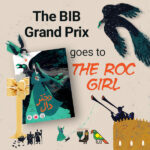The monster is one of the imaginary creatures that has a long history in children’s culture and literature. It creates fear, which has made it a tool for adults to control children and their mischief. However, in modern children’s literature, the monster has changed. Instead of being scary, it has become a friendly character, and in many stories, the monster and the child learn to coexist. The phrase “kind monster” is probably the most common way to describe this new relationship.

Formalists believe that the technique of making something feel unfamiliar loses its impact over time. So, “a new form comes in to replace the old one that no longer works.” Today, “kind monster” might not surprise children like it did a decade or two ago. It seems that the idea of the monster needs fresh ways to shake off the audience’s familiarity. The story “A Kiss for the Monster,” written by AliAsghar Seyyedabadi and illustrated by Reza Dalvand, is a great example of this.
In this story, the monster both exists and doesn’t exist. It exists as a shared idea between the father and son characters but doesn’t act as a traditional character. Thus, even though the monster keeps its classic traits, it becomes more of a playful concept.
2
“A Kiss for the Monster” is not focused on specific characters. The father and son are unnamed, representing general types: the parent and the child.
The theme and plot of the story are broader than needing unique characters. Even the fact that they are a father and son does not significantly impact the plot; it just fits better with their physical actions than if they were a mother and daughter. The story is relatable for all parents and children, regardless of their differences.
“A Kiss for the Monster” tells the story of how a parent and child connect through a playful game, ultimately leading to an emotional bond. The story has three key features:
- Enjoyable Reading: The excitement and emotions in the text make it fun for readers, drawing them in.
- Playful Nature: The story encourages a playful atmosphere, enhancing the enjoyment of the reading experience.
- Memorable Impact: The combination of humor and heartfelt moments makes the story stick in the minds of readers.
The summary of “A Kiss for the Monster” is as follows:
A boy asks his father to play “monster” together. The father agrees, raises his hands like a monster, and says, “I’m going to eat you now!” The boy feels a bit scared but replies, “You can’t eat me because I’m a monster eater!” The father then gets scared and asks, “What does a monster eater look like?” The boy responds, “Like this!” referring to an illustration. The father insists he can’t be eaten because “I am a monster eater eater.” The story continues with playful dialogues and actions between the father and son, ending with hugs and kisses filled with laughter.

3
It’s hard to separate the story from the game in “A Kiss for the Monster.” It tells a narrative about a game and is also a game dressed in a story. The story can be easily performed anywhere, making it inviting to play, but not just any play. It focuses on a specific game that fosters connection and interaction between the players, specifically the parent and child. Their interaction helps create a safe and nurturing bond.
For these reasons, “A Kiss for the Monster” can be explored in terms of how interpersonal relationships impact children’s growth. The experiences children have with their parents can lead to either secure or insecure relationships, which affect their development.
4
The formation of a “secure bond between parent and child” that leads to mental growth can be seen in “A Kiss for the Monster.” This bond has key features:
- Emotion: Emotions play a vital role. While emotions are often seen negatively, they are essential for healthy brain development and relationships.
- Connection: The emotional connection between the parent and child helps shape the child’s brain. In the story, the father’s playful monster act brings excitement, and the boy responds with a mix of fear and fun.
- Repetition: The story uses repetition to help young readers process events and understand the meaning, creating excitement with each cycle of action and reaction.
The story concludes with a strong emotional bond between the father and son. This ending is not sudden; it builds up as negative feelings of fear turn into positive emotions of laughter, leading to a happy conclusion.
5
The audience experiences all these hidden processes within the text. The relationship between the words and the illustrations plays an important role in this experience. Each time the story asks, “What does a monster eater look like?” the words remain silent, and the images provide the answer, creating a lively interaction.
Emotion, affection, physical movements, and the tone of the characters’ actions all engage the child’s mind. The story encourages imagination, allowing young readers to connect with the characters and their feelings.
In conclusion, the effects of establishing a secure bond between parent and child in early life last beyond those years. These magical moments of connection will remain significant throughout a child’s life. With such a bond, today’s child will grow into a caring adult, not just an ordinary monster kisser but a “professional” one, even when faced with life’s challenges.
Translated into English from Yashar Hodaei’s review


